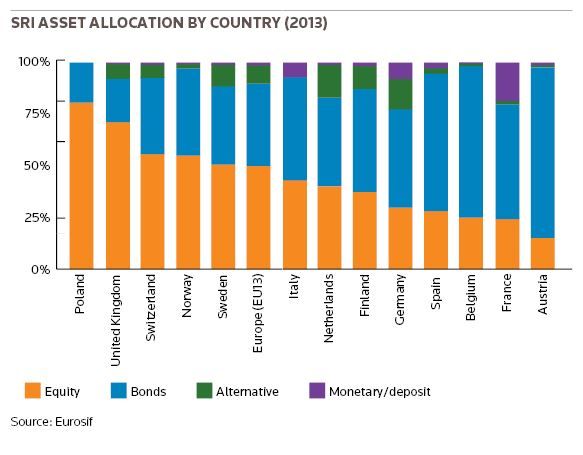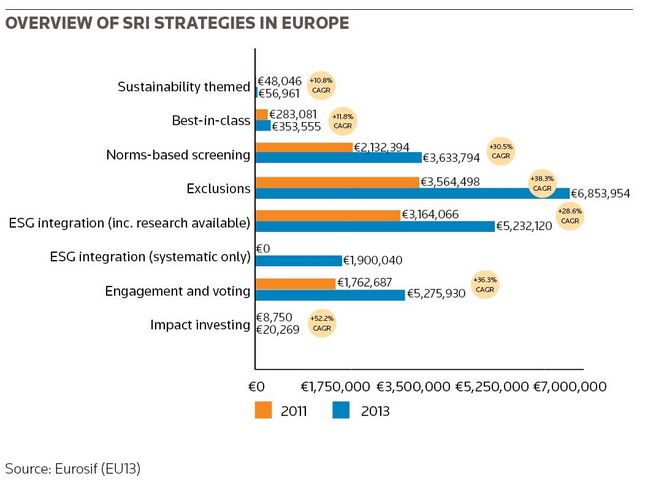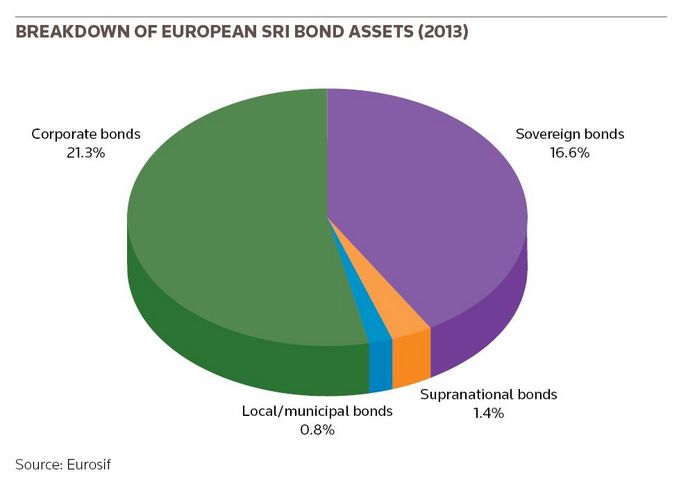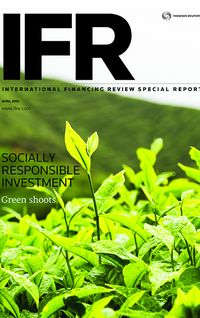SRI used to be synonymous with the equities market but it is increasingly important in the bonds space as well. While for now SRI funds remain a niche product, managers believe it is only a matter of time before the analysis they do is seen as an important part of the risk management process for mainstream investors.
Socially responsible investing (SRI) originated in Europe and remains more developed on the Continent than in the UK or US. In the US especially, where a fund manager could get sued for buying a bond that was not the best value on a purely economical basis, it was harder for SRI to take root.
The digital revolution has made the public more aware than it used to be, said Aitken Ross, investment manager, fixed income at Alliance Trust Investments.
“People are more aware of the implications of their investments abroad, which makes them feel more responsible and affects how they want to invest.”
This applies to investors in both bonds and equities.
But it would be a mistake to assume this trend is being driven by altruistic do-gooders who are more interested in social or environmental factors than returns.
“It is becoming increasingly obvious that there is a link between companies with bad environmental, social and governance (ESG) practises and bad financial outcomes,” said Mike Fox, head of sustainable investments at Royal London Asset Management. “Clients increasingly see ESG less as a specialist form of investing and more as a risk management tool managers should use to improve performance.”
Caroline Cruickshank, managing director in BNY Mellon’s corporate trust group, said: “As a concept, corporate social responsibility (CSR) has grown to the point that it influences corporate engagement with all stakeholders, including the board, shareholders, clients and employees.”
All this has implications for issuers – and the types of structures being issued.
Ashley Hamilton Claxton, corporate governance manager at RLAM, said: “Investors have been split between those who feel, as lenders rather than shareholders, there is little reason to push ESG principles, and those who see ESG as a way to identify and manage downside risk. Recently, we have seen the second view gain ground.”
Like the US and UK, the bond market is a relative newcomer to SRI and ESG investment. Equities originally attracted SRI investors because they had greater influence as a voting shareholder than they would as a lender. The relative youth of the euro corporate bond market also pushed activity towards equities. The comparative lack of public information available in fixed income markets also meant equities made more sense for investors keen to see the environmental or social impact of their investment.
The size of the fixed income market made it inevitable that it would play an increasing role in SRI. Many investors are restricted regarding what kinds of securities they can invest in, and it makes no sense to exclude such a large investor base from SRI principles.
Multi-lateral development banks kicked the process off. In 2007, the European Investment Bank and World Bank issued the first Green bond, with the structure seen as a way to finance climate mitigation projects. The financial crisis disrupted development, but since 2014, interest has again increased among both corporate and financial issuers.
The balance between bonds and equities varies across Europe.
According to the latest Eurosif data available, Poland has over 75% of its SRI assets invested in equities – the most in Europe – with the UK only a little behind.
But at the other end of the spectrum, Austria has only around 10% invested in equities, with most of its allocation to bonds. Spain, Belgium and France also have much larger SRI allocations to bonds.
Overall, equities represented about half of the European SRI assets at the end of 2013, while bonds were around 40%.
The SRI bond market is also becoming increasingly diverse.
Yo Takatsuki, associate director in the governance and sustainable investment team at BMO Global Asset Management EMEA said: “SRI is developing similarly to other investment trends by diversifying into many different forms. You have active and passive funds and ETFs, overlay and a variety of different investment approaches.”
Other structures coming under the SRI bonds umbrella include social housing debt, something with no equity market equivalent; offshore wind and other environmental infrastructure projects; and arguably microfinance, though this market has been around for decades.
But Green bonds are the most active part of the market. They have proved more useful for financing green projects than Project bonds. Investors in Project bonds are typically relatively sophisticated and have a better understanding of the specific risks around infrastructure projects. For many of them, it makes more sense to invest at the corporate entity level, which is easier to analyse than a specific project. Issuing Green instead of Project bonds maximises their appeal to the broadest number of investors.
They are also leading the way among SRI-type structures. “Green bonds are currently more sophisticated than Social Impact bonds,” said Takatsuki. “There are fewer types of projects financed by Green bonds, and it is easier to measure their impact. Social Impact bonds finance projects in many areas, from education to housing, and regional differences are greater.”
Worlds collide or worlds apart?
For managers, investing in both equities and bonds delivers certain efficiencies. Wolfgang Kuhn, head of pan-European credit at Aberdeen Asset Management, said: “Our fixed income team has benefited from the experience of our equity colleagues with regards to ESG. However, equities and corporate bonds are very separate universes, there are many names in the bond market that are too small or are unlisted or are government-owned and are therefore not available or interesting to an equity investor.”
When Aberdeen tested for overlap, it found that only about 25% of names in its bond portfolios were covered by its equities team in terms of ESG.
Cruickshank said: “I think SRI attracts the same potential investors on both the debt and equity sides. It is a group of investors … looking for financial returns as well as some environmental or social return – that is more fundamental than the structure of the security.”
Having said that, there are some generalisations to be made about equity and fixed income investors. The latter are only interested in repayment, and so value stability, whereas the former look for growth. Such cultural differences ensure SRI will take on different characteristics in the bond market than it has in equities.
Fixed income is more complicated than equities, which has relatively simple relationships by comparison. Bond investors therefore have to wrestle with questions that do not arise in equities. How should sovereigns be treated, and can a country that exports arms be considered ethical? Can coal be permissible, for example, if a bond is issued to increase its efficiency and therefore reduce emissions? There are no industry-wide answers to such questions.
“When you get into early-stage companies in equities, all you need is a couple of winners and it can pay for a larger number of losers,” said Kenny Watson, investment manager, fixed income at Alliance Trust Investments. “That doesn’t work in the bond market. But fixed income offers a larger universe, with access to public sector bodies like transport networks and universities, not seen in equities.”
“Companies often turn to the bond market earlier and the due diligence required establishes a dialogue between engineers and treasuries, highlighting environmental challenges and solutions,” said Christopher Flensborg, head of sustainable products and product development for fixed income and DCM at SEB. Treasury people can then address these issues in dialogues with investors, he added. “The bond market has also done more to get review from academics, which increases that understanding.”
While bond investors do not have the influence of being owners, engagement is still a powerful tool that gives them leverage over companies they lend to, albeit a less technical and legal kind of influence.
Takatsuki said: “The distance between the issuer and the investor is very short in the primary Green bond market, which makes it easier to see the link between the two. This allows investors to easily see the impact of their investment. In equities, there is a bigger secondary market, and with shares constantly changing hands, it is much harder for investors to make claims on that impact.”
Good for the planet, good for the wallet
Yet while investors want to see a positive impact, this is not the primary driver for SRI. Fund managers insist their success is predicated on the belief they can deliver better returns over the longer term, not because investors are willing to sacrifice returns for any moral purpose. Such funds therefore have appeal well beyond the traditional ‘ethical investor’ universe, to a broader class of investors who believe such funds are better risk-managed.
Kuhn said: “No clients have ever asked us to invest in Green or Ethical bonds without regard to value. If we invest in a Green bond, it needs to be as cheap as non-Green bond. There needs to be an economic basis for the investment.”
There are different ways to approach corporate social investment, but exclusion is among its most significant components, with many managers omitting particular sectors, such as weapons-manufacturing, from their portfolios.
Kuhn said: “In general, fixed income mandates usually come with a host of restrictions, the most basic being the focus on bonds rated investment-grade. So, the refinement of the investment universe based on ESG criteria is a natural extension of what we can do for fixed income clients.”
Selecting companies on the basis of their carbon footprint could limit returns, added Kuhn, so such criteria would have to be specified by the investor, depending on their priorities. “Because these priorities vary from investor to investor, it will be difficult for the market to agree a common approach,” he said.
Excluding oil and gas has certainly been popular among SRI managers. Martin Foden, head of credit research at Royal London Asset Management said: “We are traditionally underweight oil and gas, though recent spread-widening does make the sector look more interesting. We are continually looking for attractive return opportunities. However, any increase in investment in this area would clearly involve an evaluation of which companies offer the best governance and the lowest environmental risk.”
In 2015, the Alliance Trust Investments’ Sustainable Future Corporate Bond Fund screened out a number of big sector names, including Glencore and Petrobras, the absence of which delivered some of its alpha and gave it an advantage over its mainstream index benchmark.
Ross said: “We don’t invest in oil and gas. [Bank of England governor] Mark Carney recently said 80% of our fossil fuels can never be burned if we are to avoid the planet warming by more than two degrees. Fixed income is a long-term asset, so why would you lend for 15 or 30 years to a company where its biggest asset may never monetised?”
But oil and gas is not the only sector where managers screened names out. ESG investors sensing a problem with VW before the emissions scandal avoided losses on its bonds, or exposure to an as-yet-unspecified fine from US regulators.
But some managers are also keen to engage with companies to improve their ESG impact. For the smaller companies and state-owned enterprises that issue SRI bonds, SRI funds may be among their most significant and sophisticated creditors, which can lead to strong relationships with management and increased influence.
Takatsuki said: “SRI could transform the whole bond market by increasing pressure on issuers to show how capital is used. It is unlikely that all bonds will ever show the impact an investment has made, but if it increases the number that do, that would be very positive for the market and the broader society.”
Kuhn predicts that within 10–15 years the distinction between ESG and other types of investment will probably have disappeared. “It will be seen as simply another type of risk that needs to be managed proactively.”
Always read the label
Green bonds allow issuers to earmark money for specific projects, and offer an opportunity to reach a new group of buyers that would not otherwise invest.
Financials and corporates have been getting in on the action. Financials see them as a way to raise capital specifically to lend to eligible green projects. Corporates issue them to raise money to fund their own green initiatives, raising their CSR (corporate social responsibility) profile at a time when consumers are increasingly scrutinising the behaviour of the companies they buy from.
However, investors are advised to approach any kind of Green or ESG bond with caution, as there is no governmental oversight regarding definitions. The market is feeling its way towards common standards and there may eventually be kite marks for bonds adhering to certain standards, but this will take time. The UN has developed Principles for Responsible Investment (PRI), which the market has adopted, but they are voluntary principles. Anything more formal than this will need to be sufficiently flexible to cover the wide variety of projects being marketed to SRI investors.
On the environmental side specifically, the Climate Bonds Initiative is the closest thing to a set of eligibility standards currently available, but here too there is little standardisation between bonds. BNY Mellon’s Cruickshank said: “There is no single set of universally accepted principles for Green bonds but the market is heading in that direction, for example with the Climate Bonds Initiative. Participants understand that greater transparency is essential. That means issuers should be clear about how proceeds are distributed and tracked, and investors also demand transparency in terms of performance.”
This leaves investors with the problem of verifying that proceeds that have been raised for a specific purpose are used as promised. It is also difficult for investors to measure outcomes, and therefore to be able to compare different investments based on ESG-specific measures, rather than on returns.
With so much variety in these markets, it is a case of buyer beware: investors must not blindly accept labels saying something is SRI or green. This is not just an issue for investors but for banks too, which are still developing ways to identify the most worthy projects to finance.
To see the digital version of this special report, please click here
To purchase printed copies or a PDF of this report, please email gloria.balbastro@thomsonreuters.com







